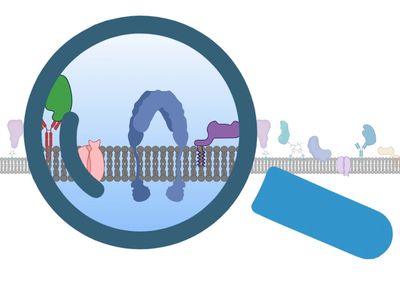Biology of Membrane Proteins
We offer diverse solutions to quantify the functions of membrane bound proteins or their binding partners in their physiological context. Many researchers have been using functionalized membranes as a membrane mimic to characterize interactions taking place at the cell membrane and intermembrane junctions. This in vitro platform retains the physical aspects of molecular interactions in appropriate biological milieu to provide a physiologically relevant and more accurate method for evaluating molecular interactions involved in cellular crosstalk and signal transduction. However, the difficulty encountered in the design and preparation of a useful functionalized membrane has precluded its widespread use in drug discovery. With more than 18 years of experience working with functionalized membranes, Cytomem has expertise in developing assays for characterizing membrane proteins with high temporal and spatial resolution. We will work with you to design platforms and assays that measures binding kinetics, functional activity, changes in mobility and oligomerization, directed rearrangement, recruitment of adapters and downstream signaling moieties, and spatial organization of membrane tethered molecules.

Functionalized Membrane Platforms
Characterization with high temporal and spatial resolution
Advanced Optical Microscopy
From optimizing protocols and obtaining images with quantitative analysis to designing and building advanced light microscopes that fit your needs, Imgenix offers comprehensive consulting and contract research services in high resolution optical microscopy.
Fluorescence Spectroscopy
Fluorescence fluctuation spectroscopy is a powerful way to determine several physiochemical properties of analytes in motion. By fluorescently tagging proteins and lipids, this collection of techniques can be used to quantify their properties in solution, in biological membranes or in intact living cells.
Sample applications

Drug efficacy (live cell-supported membrane hybrid platform)
Supported membranes are functionalized with ligands or antibodies whose surface density will be quantified. Cells expressing the appropriate receptor and/or drug of interest (small molecules or biologics) are then introduced at different concentrations and time points. Receptor engagement and activity of drug can be quantified through live cell imaging. Besides drug efficacy, this method also provide information about binding parameters between the drug-target pair.

Enzyme activities of membrane tethered molecules
One major advantage of using supported membrane is that the densities of tethered molecules are controllable and quantifiable. With proper design of experiment, this feature enables high throughput observation and measurement of membrane bound-enzyme activities in vitro. Since the kinetics of membrane bound enzymes can be significantly different in solution vs membrane bound state, this platform offers a relevant and accurate method for its quantitation.

Binding kinetics of membrane bound receptor and its ligand
Detailed binding kinetics, including on rate, off rate, and equilibrium constant, between a membrane tethered protein and its ligand can be measured easily with techniques like FCCS and single molecule tracking. The experiments can be performed both in vitro and in live cells.

Oligomerization (clustering) of membrane proteins
Clustering and spatial organization of membrane proteins can be quantified using fluorescence spectroscopy (FCS/FCCS, photon counting histogram analysis) or single molecule tracking. The effects of drugs that disrupt this structural motifs can also be studied these methods. These methods work well for in vitro systems as well as live cells.